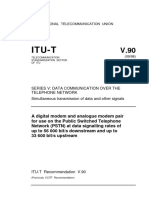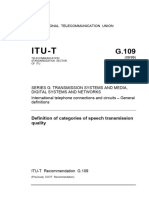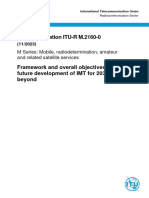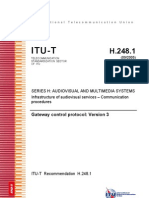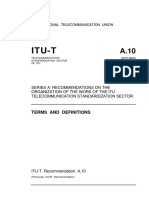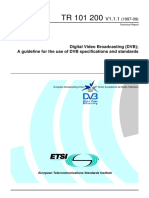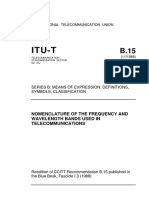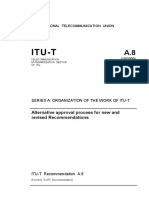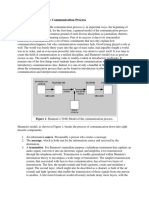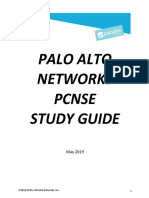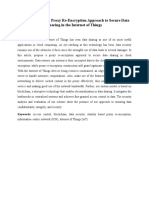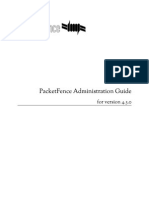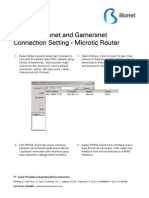T Rec C.3 198811 S!!PDF e
T Rec C.3 198811 S!!PDF e
Uploaded by
Le TwoCopyright:
Available Formats
T Rec C.3 198811 S!!PDF e
T Rec C.3 198811 S!!PDF e
Uploaded by
Le TwoOriginal Title
Copyright
Available Formats
Share this document
Did you find this document useful?
Is this content inappropriate?
Copyright:
Available Formats
T Rec C.3 198811 S!!PDF e
T Rec C.3 198811 S!!PDF e
Uploaded by
Le TwoCopyright:
Available Formats
INTERNATIONAL TELECOMMUNICATION UNION
CCITT C.3
THE INTERNATIONAL (11/1988)
TELEGRAPH AND TELEPHONE
CONSULTATIVE COMMITTEE
SERIES C: GENERAL TELECOMMUNICATION
STATISTICS
INSTRUCTIONS FOR INTERNATIONAL
COMMUNICATION SERVICES
Reedition of CCITT Recommendation C.3 published in
the Blue Book, Fascicle I.3 (1988)
NOTES
1 CCITT Recommendation C.3 was published in Fascicle I.3 of the Blue Book. This file is an extract from the
Blue Book. While the presentation and layout of the text might be slightly different from the Blue Book version, the
contents of the file are identical to the Blue Book version and copyright conditions remain unchanged (see below).
2 In this Recommendation, the expression Administration is used for conciseness to indicate both a
telecommunication administration and a recognized operating agency.
ITU 1988, 2006
All rights reserved. No part of this publication may be reproduced, by any means whatsoever, without the prior written
permission of ITU.
Recommendation C.3
INSTRUCTIONS FOR INTERNATIONAL
COMMUNICATION SERVICES
The CCITT,
considering
(a) Resolutions Nos. 1 and 3 of the World Administrative Telegraph and Telephone Conference (Geneva,
1973) concerning the Instructions for the Operation of the International Public Telegram Service and Telex Operation
and Tariff Principles, respectively.
(b) that Article 26 of the Radio Regulations (Geneva, 1979) requires the Manual for Use by the Maritime
Mobile and Maritime Mobile-Satellite Services to contain the Instructions for the International Public Telegram Service
and the International Telephone Service;
(c) that, in the draft International Telecommunication Regulations submitted by the CCITT for consideration
at the World Administrative Telegraph and Telephone Conference (Melbourne, 1988), Article 1 refers to the need to
comply with Recommendations and Instructions, while not implying that they have the same legal status as Regulations;
(d) that, in the same draft Regulations, Instructions are defined as consisting of provisions from a CCITT
Recommendation or Recommendations dealing with practical operating procedures for the handling of
telecommunication traffic (e.g. acceptance, transmission, accounting);
(e) that, provisions to be designated as Instructions are so designated for one or more of the following
reasons:
their observance on a world-wide basis is of particular importance for the orderly and efficient operation
of the international telecommunication service(s) concerned;
it may be convenient to publish them as a separate booklet for use by operators;
the provisions (or subsequent amendments to them) may need to enter into effect at a specified time
throughout the world;
unanimously declares the view
(1) that Administrations should apply the detailed operational procedures laid down in the Instructions, which
are constitued as shown in Table 1/C.3 below;
(2) that when modifications are made to the text of Instructions, the Plenary Assembly approving them should
also indicate the date of their entry into force, in order to facilitate their world-wide observance in a coordinated manner.
In setting this date, due account should be taken of the time required for the publication of the modifications, as well as
for their distribution to the operation services concerned.
TABLE 1/C.3
Service Recommendations Sections pertinentes
International telephone service E.141 All
International public telegram service F.1, F.42, D.40, D.42, D.43, D.98 All
International telex service F.60, F.61, F.67 All
Maritime mobile services F.110/E.200, D.90 All
Fascicle I.3 Rec. C.3 1
ITU-T RECOMMENDATIONS SERIES
Series A Organization of the work of the ITU-T
Series B Means of expression: definitions, symbols, classification
Series C General telecommunication statistics
Series D General tariff principles
Series E Overall network operation, telephone service, service operation and human factors
Series F Non-telephone telecommunication services
Series G Transmission systems and media, digital systems and networks
Series H Audiovisual and multimedia systems
Series I Integrated services digital network
Series J Transmission of television, sound programme and other multimedia signals
Series K Protection against interference
Series L Construction, installation and protection of cables and other elements of outside plant
Series M TMN and network maintenance: international transmission systems, telephone circuits, telegraphy,
facsimile and leased circuits
Series N Maintenance: international sound programme and television transmission circuits
Series O Specifications of measuring equipment
Series P Telephone transmission quality, telephone installations, local line networks
Series Q Switching and signalling
Series R Telegraph transmission
Series S Telegraph services terminal equipment
Series T Terminals for telematic services
Series U Telegraph switching
Series V Data communication over the telephone network
Series X Data networks and open system communications
Series Y Global information infrastructure and Internet protocol aspects
Series Z Languages and general software aspects for telecommunication systems
Printed in Switzerland
Geneva, 2006
You might also like
- Zonal Office List With All 11 Circle OfficesDocument30 pagesZonal Office List With All 11 Circle OfficesSahil Hasan100% (1)
- B310s-22TCPU-V200R001B321D03SP00C00 Firmware - Release - NotesDocument14 pagesB310s-22TCPU-V200R001B321D03SP00C00 Firmware - Release - NotesJulio Luis CalderonNo ratings yet
- 6 - Itu-R M.2010 NavdatDocument21 pages6 - Itu-R M.2010 NavdatTran HoangNo ratings yet
- UNM2000 Training PDFDocument77 pagesUNM2000 Training PDFcukjaya100% (1)
- T Rec B.18 198811 S!!PDF e PDFDocument4 pagesT Rec B.18 198811 S!!PDF e PDFlethanhthreeNo ratings yet
- T Rec A.23 200010 I!!pdf eDocument8 pagesT Rec A.23 200010 I!!pdf eBudi PramonoNo ratings yet
- T Rec A.14 199303 S!!PDF eDocument6 pagesT Rec A.14 199303 S!!PDF elethanhoneNo ratings yet
- International Telecommunication Union: RecommendationDocument3 pagesInternational Telecommunication Union: RecommendationLe TwoNo ratings yet
- Itu-T: Collection and Publication of Official Service InformationDocument8 pagesItu-T: Collection and Publication of Official Service InformationLe TwoNo ratings yet
- T Rec A.22 198811 S!!PDF eDocument4 pagesT Rec A.22 198811 S!!PDF elethanhoneNo ratings yet
- T REC V.92 200307 I!Cor1!PDF EDocument10 pagesT REC V.92 200307 I!Cor1!PDF EridhaNo ratings yet
- T Rec A.12 200010 S!!PDF eDocument10 pagesT Rec A.12 200010 S!!PDF elethanhoneNo ratings yet
- Itu-R G.828Document6 pagesItu-R G.828toyski1974No ratings yet
- $igital Multi Programme Systems For Television Sound and Data Services For Cable DistributionDocument67 pages$igital Multi Programme Systems For Television Sound and Data Services For Cable DistributionMike JonesNo ratings yet
- International Telecommunication Union: RecommendationDocument92 pagesInternational Telecommunication Union: Recommendationsivasundar77No ratings yet
- T Rec A.14 198811 S!!PDF eDocument4 pagesT Rec A.14 198811 S!!PDF elethanhoneNo ratings yet
- T Rec B.19 198811 S!!PDF eDocument6 pagesT Rec B.19 198811 S!!PDF elethanhthreeNo ratings yet
- T Rec A.20 198811 S!!PDF eDocument6 pagesT Rec A.20 198811 S!!PDF eLe TwoNo ratings yet
- Itu-T V.90-1998Document50 pagesItu-T V.90-1998Peter LeaderNo ratings yet
- T Rec G.109 199909 I!!pdf eDocument11 pagesT Rec G.109 199909 I!!pdf eperNo ratings yet
- T Rec Q.1901 200006 I!!pdf eDocument8 pagesT Rec Q.1901 200006 I!!pdf eM8Rafwkj1No ratings yet
- Ccitt: Network Grade of Service Parameters in IsdnDocument6 pagesCcitt: Network Grade of Service Parameters in IsdnAmit ChoubeyNo ratings yet
- R Rec M.493 15 201901 I!!pdf eDocument64 pagesR Rec M.493 15 201901 I!!pdf eAlok BhargavaNo ratings yet
- R Rec M.2012 0 201201 I!!pdf eDocument113 pagesR Rec M.2012 0 201201 I!!pdf ematupa2No ratings yet
- Ccitt: Major Degradation or Disruption of ServiceDocument4 pagesCcitt: Major Degradation or Disruption of ServiceLe TwoNo ratings yet
- Adjacent Band InterferenceDocument20 pagesAdjacent Band InterferenceA. VillaNo ratings yet
- Ccitt: Major Degradation or Disruption of ServiceDocument4 pagesCcitt: Major Degradation or Disruption of ServicelethanhthreeNo ratings yet
- T Rec A.30 198811 S!!PDF eDocument4 pagesT Rec A.30 198811 S!!PDF elethanhoneNo ratings yet
- Appendix 18Document17 pagesAppendix 18Vasile PipirigeanuNo ratings yet
- Identification and Layout of ITU-T RecommendationsDocument10 pagesIdentification and Layout of ITU-T RecommendationsLe TwoNo ratings yet
- Itu-T: End-User Multimedia Qos CategoriesDocument18 pagesItu-T: End-User Multimedia Qos CategoriesMuchlis GinanjarNo ratings yet
- T REC G.7712 201310 I!Amd1!PDF EDocument12 pagesT REC G.7712 201310 I!Amd1!PDF ErajaramghoshNo ratings yet
- Compatibility Between The Sound-Broadcasting Service in The Band of About 87-108 MHZ and The Aeronautical Services in The Band 108-137 MHZDocument47 pagesCompatibility Between The Sound-Broadcasting Service in The Band of About 87-108 MHZ and The Aeronautical Services in The Band 108-137 MHZhachung86No ratings yet
- T Rec G.100 200102 I!!pdf eDocument38 pagesT Rec G.100 200102 I!!pdf eLuong Hong ThangNo ratings yet
- ITU Maritime Mobile IdentitiesDocument11 pagesITU Maritime Mobile Identitiessgodofthunders17No ratings yet
- T Rec G.984.3 2014Document170 pagesT Rec G.984.3 2014chiru.mihaiNo ratings yet
- R Rec S.1878 0 201012 I!!pdf eDocument20 pagesR Rec S.1878 0 201012 I!!pdf efantomaveselaNo ratings yet
- Digital Land Mobile Systems ForDocument103 pagesDigital Land Mobile Systems ForaminichangeezNo ratings yet
- R Rep M.2418 2017 PDF eDocument17 pagesR Rep M.2418 2017 PDF eBogdan KstNo ratings yet
- T Rec A.12 201611 I!!pdf eDocument8 pagesT Rec A.12 201611 I!!pdf eLeo ChanakaNo ratings yet
- ITU-R - M.2160 ReportDocument21 pagesITU-R - M.2160 ReportfnoyanisiNo ratings yet
- Digital Selective-Calling System For Use in The Maritime Mobile ServiceDocument64 pagesDigital Selective-Calling System For Use in The Maritime Mobile ServiceCarlo GiordaniNo ratings yet
- T Rec H.248.1 200509 I!!pdf eDocument206 pagesT Rec H.248.1 200509 I!!pdf etrantuankmaNo ratings yet
- Digital Voice Communication in The VHFDocument69 pagesDigital Voice Communication in The VHFaminichangeezNo ratings yet
- T Rec G.692 199810 I!!pdf eDocument41 pagesT Rec G.692 199810 I!!pdf eGleb IsayevNo ratings yet
- Unit5 AllDocument106 pagesUnit5 AllnodagalaaswiniNo ratings yet
- Telecommunication TerminalsDocument13 pagesTelecommunication TerminalsMiki ArsovskiNo ratings yet
- T Rec G.103 199812 I!!pdf eDocument21 pagesT Rec G.103 199812 I!!pdf emfw09204No ratings yet
- Template BR Rec 2005Document42 pagesTemplate BR Rec 2005djrokr99No ratings yet
- Itu-T: Gateway Control Protocol: Enhanced Digit Collection Packages and ProceduresDocument17 pagesItu-T: Gateway Control Protocol: Enhanced Digit Collection Packages and ProceduresairamorrNo ratings yet
- Itu-T: Terms and DefinitionsDocument6 pagesItu-T: Terms and DefinitionsLe TwoNo ratings yet
- International Telecommunication Union (ITU)Document56 pagesInternational Telecommunication Union (ITU)humura hamura100% (1)
- 5gnr Spec Imt-2020Document255 pages5gnr Spec Imt-2020yorimafu ZXNo ratings yet
- Detailed Specifications of The Terrestrial ITU RDocument210 pagesDetailed Specifications of The Terrestrial ITU RYose FirdausNo ratings yet
- T Rec X.220 199303 I!!pdf e PDFDocument6 pagesT Rec X.220 199303 I!!pdf e PDFelracoNo ratings yet
- Planning, Design and Implementation of HF Fixed Service Radio SystemsDocument32 pagesPlanning, Design and Implementation of HF Fixed Service Radio SystemsArturo MontielNo ratings yet
- T Rec G.984.3 200402 S!!PDF eDocument116 pagesT Rec G.984.3 200402 S!!PDF eAnonymous GK9mHwnrNo ratings yet
- IMT Advanced SpecsDocument168 pagesIMT Advanced SpecsOsama El MesalawyNo ratings yet
- R Rec M.2083 0 201509 I!!pdf eDocument21 pagesR Rec M.2083 0 201509 I!!pdf eJMColsNo ratings yet
- TR 101 200Document13 pagesTR 101 200Aman SinghNo ratings yet
- T Rec G.7041 200112 S!!PDF eDocument52 pagesT Rec G.7041 200112 S!!PDF eHimanshu SrivastavaNo ratings yet
- T Rec C.1 199303 W!!PDF e PDFDocument12 pagesT Rec C.1 199303 W!!PDF e PDFLe TwoNo ratings yet
- T Rec B.11 198811 W!!PDF eDocument3 pagesT Rec B.11 198811 W!!PDF eLe TwoNo ratings yet
- T Rec C.2 199610 S!!PDF eDocument7 pagesT Rec C.2 199610 S!!PDF eLe TwoNo ratings yet
- T Rec B.1 198811 W!!PDF eDocument3 pagesT Rec B.1 198811 W!!PDF eLe TwoNo ratings yet
- T Rec B.14 198811 W!!PDF eDocument4 pagesT Rec B.14 198811 W!!PDF eLe TwoNo ratings yet
- T Rec B.15 198811 S!!PDF e PDFDocument6 pagesT Rec B.15 198811 S!!PDF e PDFLe TwoNo ratings yet
- T Rec B.16 198811 W!!PDF e PDFDocument7 pagesT Rec B.16 198811 W!!PDF e PDFLe TwoNo ratings yet
- Ccitt: Major Degradation or Disruption of ServiceDocument4 pagesCcitt: Major Degradation or Disruption of ServiceLe TwoNo ratings yet
- T REC A.Sup3 200111 S!!PDF E PDFDocument14 pagesT REC A.Sup3 200111 S!!PDF E PDFLe TwoNo ratings yet
- Itu-T: Focus Groups: Working Methods and ProceduresDocument12 pagesItu-T: Focus Groups: Working Methods and ProceduresLe TwoNo ratings yet
- T REC A.Sup1 199809 W!!PDF EDocument19 pagesT REC A.Sup1 199809 W!!PDF ELe TwoNo ratings yet
- Alternative Approval Process For New and Revised RecommendationsDocument12 pagesAlternative Approval Process For New and Revised RecommendationsLe TwoNo ratings yet
- Itu-T: Focus Groups: Working Methods and ProceduresDocument12 pagesItu-T: Focus Groups: Working Methods and ProceduresLe TwoNo ratings yet
- Itu-T: Terms and DefinitionsDocument6 pagesItu-T: Terms and DefinitionsLe TwoNo ratings yet
- Identification and Layout of ITU-T RecommendationsDocument10 pagesIdentification and Layout of ITU-T RecommendationsLe TwoNo ratings yet
- English 9 Research Paper - ParksDocument4 pagesEnglish 9 Research Paper - ParksGabriel ParksNo ratings yet
- Image Processing MR Biren PatelDocument103 pagesImage Processing MR Biren PatelcutesandNo ratings yet
- Best Final DDK HSR BothDocument54 pagesBest Final DDK HSR Bothishantkathuria0% (1)
- BC-312-N, TM 11-850 NDocument115 pagesBC-312-N, TM 11-850 NMichael M. StarkeNo ratings yet
- IP Address SeriesDocument5,828 pagesIP Address SeriesSyed GulamNo ratings yet
- NSE 2 The Evolution of Cybersecurity Web Application Firewall QuizDocument3 pagesNSE 2 The Evolution of Cybersecurity Web Application Firewall QuizAnonymous MmzpUK50% (12)
- DS-3T0510HP-E HS Datasheet 20240315Document5 pagesDS-3T0510HP-E HS Datasheet 20240315DILMER JAVIERNo ratings yet
- Figure 1: Shannon's (1948) Model of The Communication ProcessDocument2 pagesFigure 1: Shannon's (1948) Model of The Communication ProcessMuhammadNo ratings yet
- GXP 1625Document54 pagesGXP 1625Mateo PaisaNo ratings yet
- Network DevicesDocument33 pagesNetwork DevicesFrancis PulaiziNo ratings yet
- Pcnse Study GuideDocument308 pagesPcnse Study GuideElizabeth Parsons100% (2)
- Chapter-6 Cellular Communication - Generations 1G To 5GDocument10 pagesChapter-6 Cellular Communication - Generations 1G To 5GresearchmujNo ratings yet
- WPS ICT Handbook, Term 2, 2024Document28 pagesWPS ICT Handbook, Term 2, 2024kudakwashe mkotaNo ratings yet
- SingleRAN Hardware Roadmap (2015Q3) PDFDocument48 pagesSingleRAN Hardware Roadmap (2015Q3) PDFchihebNo ratings yet
- Datasheet - Hexaband APE4518R14v06 PDFDocument3 pagesDatasheet - Hexaband APE4518R14v06 PDFJulian CadenaNo ratings yet
- Huawei Y7 Pro 2019Document14 pagesHuawei Y7 Pro 2019hendrexNo ratings yet
- Micom C264-Rtu PDFDocument4 pagesMicom C264-Rtu PDFCepi SukmayaraNo ratings yet
- Ahb7016t LMDocument3 pagesAhb7016t LMturadettaNo ratings yet
- CSMA PPT 2101714029Document8 pagesCSMA PPT 2101714029kharshitha176No ratings yet
- Computer Networks Question BankDocument7 pagesComputer Networks Question BankrahupiNo ratings yet
- Blockchain Based Proxy Re-EncryptionDocument8 pagesBlockchain Based Proxy Re-EncryptionBhanu RoyalNo ratings yet
- Switching Lab-05b Configuring InterVLAN RoutingDocument2 pagesSwitching Lab-05b Configuring InterVLAN RoutingHernan E. SalvatoriNo ratings yet
- PacketFence Administration Guide-4.3.0 PDFDocument117 pagesPacketFence Administration Guide-4.3.0 PDFLuis Gamboa CantoNo ratings yet
- 02 Chapter 02 - Network Architecture TopologiesDocument31 pages02 Chapter 02 - Network Architecture TopologiesThe ShieldNo ratings yet
- Mod 1 DCNDocument17 pagesMod 1 DCNSUREDDY TANUJA MSCS2018No ratings yet
- Odv 065r17e18jjj GDocument1 pageOdv 065r17e18jjj GJhoan Daniel100% (1)
- Biznet Metronet - Connection Setting - Microtic RouterDocument9 pagesBiznet Metronet - Connection Setting - Microtic RouterChoky AconkNo ratings yet



















